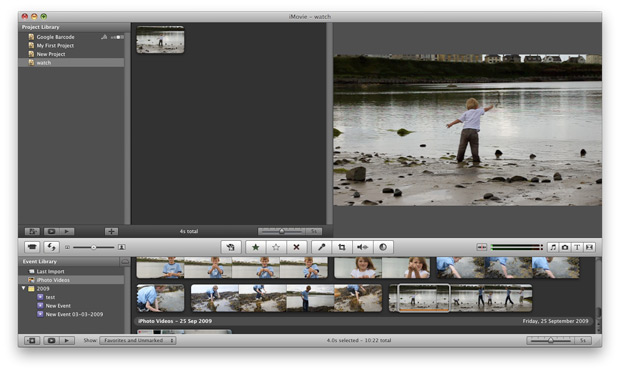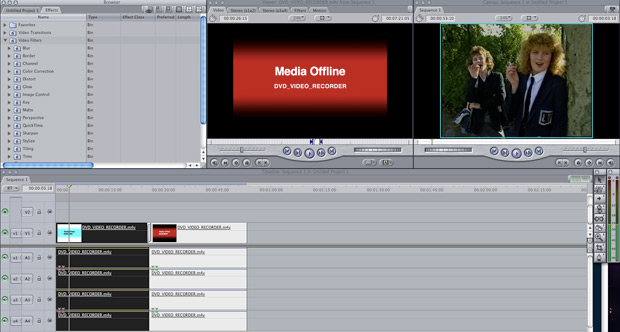We are frequently asked what Mac video editing we would recommend for general classroom use, iMovie or Final Cut Express. Personally speaking, although I primarily teach students to use Final Cut I also use iMovie in equal amounts. This is a quick guide to outline how I use both FCE and iMovie and the benefits /drawbacks of each. If you are hoping for a winner well it really depends on how you want to work and be creative with video.
iMovie
iMovie comes as part of the iLife suite of applications and thus is available on every new Mac. I very much view iMovie as a quick editing solution with a fast turn around workflow.
I primarily use iMovie with video captured using my Digital SLR. iMovie automatically indexes video files held in your iPhoto library which makes access to my various family clips really easy.
I tend to use iMovie to quickly chop, edit and add soundtrack to family films and then share them via iTunes for my iPhone and Apple TV and share the films securely with friends and family via MobileMe. iMovie offers both direct to MobileMe and YouTube as a one click export option.

iMovie covers the basics of editing. You can trim, crop, re-order, add image effects, text, transitions and media from your iPhoto and iTunes libraries.
There are some sound controls but they are limited to the audio from the recorded clip and a single secondary audio source (e.g. a music track from your iTunes library.
One of the best features for a quick turn around are the stunning iMovie templates that come with iLife 09. I find iMovie video creations tend to be a number of short 1 minute clips of events and trips.
iMovie offers a brilliant way of bringing these video snapshots together into a a single video production using stunning video transitions to link the footage. iMovie is fast, easy to use and produces a range of outputs ready formated for iPod, iPhone, Apple TV or Mp4 video.
Pros:
- iMovie is very easy to use and high quality video products can be created and shared quickly.
- Copes with HD formats from DSLR , AVCHD and Flip videos it also natively supports editing of Mp4 video.
- Adding media from your iPhoto and iTunes library is easy.
- Templates make presenting a number of clips look professional and will definitely impress the family.
- Exporting is easy with a number of presets for popular devices such as iPhone, AppleTV.
- Direct export to MobileMe and YouTube.
Cons:
- Single video and audio lines.
- Limited control of effects and transitions and these can’t be easily customised.
- Narrative based film creation possible but can be difficult to build.
- Limited control of text.
- No advanced features such as Chroma-key etc.
Final Cut Express
Final Cut isn’t an expensive application given the power and control it offers for editing video footage. Basically there is no limit to the creativity it offers both in terms of editing and also post production.
 Remember than FCE’s big brother Final Cut Pro isn’t massively different from Express and is used in professional TV and film production. (e.g. Reign Over Me (2007)).
Remember than FCE’s big brother Final Cut Pro isn’t massively different from Express and is used in professional TV and film production. (e.g. Reign Over Me (2007)).
In fact the features omitted from the Express version really aren’t going to be missed by a home or small studio user.
Final Cut allows you to edit like a professional and it offers state of the art effects, transitions and editing functionality with Insert, overwrite, fit-to-fill, and more. To add clips, simply drag them into the Timeline.
I tend to use Final Cut Express for creating narrative based films or creative montages. Final Cut Express offers complete freedom of how video is edited and altered.
The multi-layer video and audio approach means you can create sophisticated TV style title overlays as well as sophisticated picture-in-picture or side-by-side video effects.

FCE offers a massive number of video and audio layers. This means you can add video on top of other video (for example you can change the top layer opacity to create a ghostly effect).
Editing is FCE is carried out via a timeline with media from your “media bin” being dragged onto the timeline for easy editing. You can view the video clip currently being editing and the complete timeline on screen at once.
The editing process in FCE takes longer but offers much more scope for creativity and control. If you want a narrative/story based film production then FCE offers everything you would possibly need.
FCE also offers a massive range of effects and you can fine tune these to enhance or transform your video or audio footage. Basically the only limit with FCE is your own creativity.
Pros:
- Multiple video and audio tracks.
- Large number of effects that can be fine tuned and customised.
- Full control over video and audio including full audio mixer and the ability to freely position video.
- TImeline based editing making narrative creations easy.
- Support for all types of media including transparent PNG.
- Unlimited control of text and titles
Cons:
- Slightly steeper learning curve than iMovie
- Media has to be imported to the media bin manually (i.e. no native iLife support).
- MP4 editing can be slow.
- Footage needs to be rendered to be previewed or exported.
- Unlimited export options but this means no quick export settings for popular devices.
Conclusion
As I mentioned at the start of this article I use iMovie just as much as I use Final Cut. iMovie is ideal for quickly editing and sharing videos with a class, family or friends and thus it is ideal for the ‘YouTube generation’. If you want to take your editing to the next level then FCE is definitely worth considering.
If are thinking of studying film or want to use film to be creative then you can’t go far wrong with FCE and the skills you learn in this application would stand you in good stead in the professional setting career wise.
Last modified: February 26, 2011









